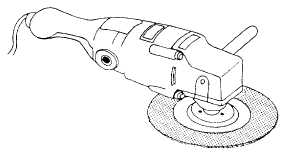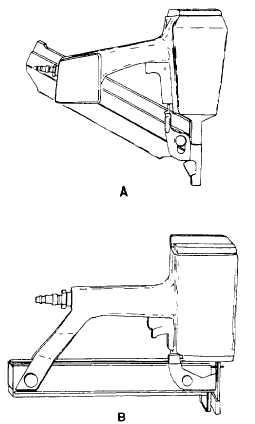
Figure 3-26.-Portable disk sander.
models are usually 3 or 4 inches. Depending make and model, belt lengths vary from 21 on the to 27 inches. Different grades of-abrasives are available.
The disk sander (figure 3-26) is a useful tool for removing old finish, paint, and varnish from siding, wood flooring, and concrete. For best results with a disk sander, tip the machine lightly with just enough pressure to bend the disk. Use a long, sweeping motion, back and forth, advancing along the surface. When using a disk sander, always operate it with both hands.
The finish sander (figure 3-27) is used for light and fine sanding. Two kinds of finish sanders are available. One operates with an orbital (circular) motion (view A), and the other has an oscillating (back and forth) movement (view B). Finish sanders use regular abrasive paper (sandpaper) cut to size from full sheets.
Observe the following safety tips when operating portable sanders:
Make sure the sander is off before plugging it in.
Make sure that you use two hands if using the belt sander.
Don't press down on the sander. The weight of the sander is enough to sand the material.
Make sure the sander is disconnected when changing sandpaper.
Keep the electrical cord away from the area being sanded.
Power Nailers and Staplers
There is a wide variety of power nailers and staplers available. A typical example of each is shown in figure 3-28. A heavy-duty nailer is used for

Figure 3-27.-Two types of finish sanders: orbital (view A) and oscillating (view B).

Figure 3-28.-Heavyduty pneumatic nailer (view A) and pneumatic stapler (view B).
Continue Reading